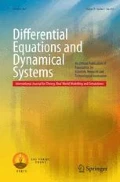Abstract
A gas composed of identical isotropic molecules has a potential energy of interaction between pairs of particles that depends only on their separation distance. The pair potential is encoded in the virial coefficients of the virial equation of state for a gas.
The complete iterative inversion method is a technique employed in an attempt to recover the pair potential from the second virial coefficient. Implicit in the complete iterative inversion method is the requirement that various mathematical expressions are meaningful: improper integrals converge, derivatives exist, etc.We provide a mathematical framework in which all these implicit assumptions are valid. We show that the complete iterative inversion method cannot recover the pair potential even if the target potential and the initial estimate are infinitely differentiable.
Similar content being viewed by others
References
Boushehri A., Viehland L. A. and Mason E. A., Direct determination of interaction potentials from gas viscosity measurements alone, Chem. Phys., 28, 313–318, (1977)
Colton D. et al., Surveys on solution methods for inverse problems, Springer-Verlag, New York, (2000)
Cox H. E., Crawford F. W., Smith E. B. and Tindell A. R., A complete iterative inversion procedure for second virial coefficient data, I. The Method, Molec. Phys., 40, 705–712, (1980)
Dymond J. H. and Smith E. B., The virial coefficients of pure gases and mixtures, Clarendon Press, Oxford, (1980)
Frisch H. L. and Helfand E., Conditions imposed by gross properties on the intermolecular potential, J. Chem. Phys., 32, 269–270, (1960)
Hewitt E. and Stromberg K., Real and Abstract Analysis, Springer-Verlag, New York, (1965)
Hirschfelder J. O., Curtiss C. F. and Bird R. B., Molecular Theory of Gases and Liquids, John Wiley & Sons, New York, (1964)
Lemes N. H. T., Braga J. P. and Belchior J. C., Spherical potential energy function from second virial coefficient using Tikhonov regularization and truncated singular value decomposition, Chem. Phys. Let., 296, 233–238, (1998)
Mason E. A. and Spurling T. H., The Virial Equation of State, Pergamon Press, Oxford, (1969)
Maitland G. C., Mason E. A., Viehland L. A. and Wakeham W. A., A justification of methods for the inversion of gas transport coefficients, Molec. Phys., 36, 797–816, (1978)
Maitland G. C., Rigby M., Smith E. B. and Wakeham W. A., Intermolecular Forces-Their Origin and Determination, Clarendon Press, Oxford, (1981)
Maitland G. C. and Smith E. B., The direct determination of potential energy functions from second virial coefficients, Molec. Phys., 24, 1185–1201, (1972)
Royden H. L., Real Analysis (third edition), Prentice-Hall, Englewood Cliffs, NJ, (1988)
Rudd W. G., Frisch H. L. and Louis Brickman, Inversion of the classical second virial coefficient, Stat. Phys., 5, 133–135, (1972)
Saks S. and Zygmund A., Analytic Functions (third edition), Elsevier, Amsterdam, (1971)
Sengers J. V. [editor], Equations of State for Fluids and Fluid Mixtures, Elsevier, Amsterdam, (2000)
Singh S. R. and Zerner M. C., On the inversion of the classical second virial coefficient, Stat. Phys., 14, 351–357, (1976)
Smith E. B., Tindell A. R., Wells B. H. and Crawford F. W., A complete iterative inversion procedure for second virial coefficient data, II. Applications, Molec. Phys., 42, 937–942, (1981)
Smith E. B., Tindell A. R., Wells B. H. and Tildesley D. J., On the inversion of second virial coefficient data derived from an undisclosed potential energy function, Molec. Phys., 40, 997–998, (1980)
Viehland L. A., Interaction potentials for systems, Chem. Phys., 78, 279–294, (1983)
Viehland L. A., Harrington M. M. and Mason E. A., Direct determination of ion-neutral molecule interaction potentials from gaseous ion mobility measurements, Chem. Phys., 17, 433–441, (1976)
van der Waals J. D., On the continuity of the gaseous and liquid states, Ph.D. thesis (in Dutch), University of Leiden, 1873. (Republished in an English translation by Dover Publications in 1988 with an introduction and commentary by J. S. Rowlinson.)
Author information
Authors and Affiliations
Rights and permissions
About this article
Cite this article
Grow, D., Insall, M. Mathematical analysis of the complete iterative inversion method — I. Differ Equ Dyn Syst 17, 419–433 (2009). https://doi.org/10.1007/s12591-009-0029-3
Published:
Issue Date:
DOI: https://doi.org/10.1007/s12591-009-0029-3
Keywords
- Second virial coefficient
- Spherical intermolecular potential
- Equations of state for a gas
- Integral equation
- Iterative inversion




